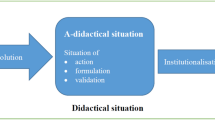Abstract
In this paper, we use the theory of didactic situations to characterize a mathematics teaching practice, currently used in secondary schools in France, which we have called interactive synthesis discussion. We have studied this practice in ordinary classes, i.e. classes where the researcher intervenes neither in the preparation nor in the management of the lessons. We have looked at the didactic situations the teacher chooses, and how he manages his teaching project, the students’ work in the classroom and at home, and classroom interactions. We present two case studies of experienced teachers, one in grade 8, and the other in grade 10.
Similar content being viewed by others
References
Artigue, M.: 1992, ‘Didactic engineering’, in R. Douady and A. Mercier (eds.), Research in Didactique of mathematics. Selected papers, extra issue of Recherches en didactique des mathématiques, La Pensée sauvage, Grenoble, pp. 41–65.
Artigue, M. and Perrin-Glorian, M.J.: 1991, ‘Didactic engineering, research and development tool: Some theoretical problems linked to this duality”, For the learning of Mathematics 11(1), 13–17.
Balacheff, N.: 1987, ‘Processus de preuve et situations de validation’, Educational Studies in Mathematics 18, 147–176.
Ball, D.L., Lubienski, S.T. and Mewborn, D.S.: 2001, ‘Research on teaching mathematics: The unsolved problem of teachers’ mathematical knowledge’, in V. Richardson (ed.), Handbook of research on teaching, 4th ed., American Educational Research Association, Washington, D.C., pp. 433–456.
Bartolini Bussi, M.G.: 1994, ‘Theoretical and empirical approaches to classroom interaction’, in Biehler, Scholz, Stasser and Winkelmann (eds.), Didactic of Mathematics as a Scientific Discipline, Kluwer Academic Publishers, Dordrecht, pp. 121–132.
Bauersfeld, H.: 1994, ‘Theoretical perspectives on interactions in the mathematical classroom’, in Biehler, Scholz, Stasser and Winkelmann (eds.), Didactic of Mathematics as a Scientific Discipline, Kluwer Academic Publishers, Dordrecht, pp. 133–146.
Brousseau, G.: 1996, ‘L’enseignant dans la théorie des situations didactiques’, in Perrin-Glorian, M.J. and Noirfalise, R. (eds.), Actes de la 8 ‘eme Ecole d”Eté de didactique des mathématiques, I.R.E.M. de Clermont-Ferrand, pp. 3–46; A longer version developed in a lecture in Montreal may be found online http://dipmat.math.unipa.it/grim/homebrousseau.htm.
Brousseau, G.: 1997, Theory of didactical situations in mathematics. Didactique des mathématiques 1970–1990, Kluwer Academic Publishers, Dordrecht, 336p.
Brousseau, G. and Centeno, J.: 1991, ‘La mémoire du systéme didactique’, Recherches en Didactique des Mathématiques, 11(2–3), 167–210.
Chevallard, Y.: 1992, ‘Concepts fondamentaux de la didactique: Perspectives apportées par une approche anthropologique”, Recherches en Didactique des Mathématiques 12(1), 73–111.
Chevallard, Y.: 1999, ‘Pratiques enseignantes en théorie anthropologique’, Recherches en Didactique des Mathématiques 19(2), 221–266.
Comiti, C. and Grenier, D.: 1997, ‘Régulations didactiques et changements de contrats’, Recherches en didactique des mathématiques 17 (3), 81–102.
Douady, R.: 1987, ‘Jeux de cadres et dialectique outil-objet’, Recherches en Didactique des Mathématiques 7(2), 5–31.
Herbst, P. and Kilpatrick, J.: 1999, ‘Pour lire Brousseau’, For the learning of mathematics 19(1), 3–10.
Hersant, M.: 2001, Interactions didactiques et pratiques d’enseignement, le cas de la proportionnalité au collège, Thèse de l’Université Paris 7.
Hersant, M.: 2003, ‘Des logiciels dans les classes: impact sur les connaissances des élèves et intégration à l’enseignement. Un exemple avec “La proportionnalité à travers des problèmes“ ”, Petit x 61, 35–60.
Hersant, M.: 2004, ‘Caractérisation d’une pratique d’enseignement des mathématiques, le cours dialogué’, Revue canadienne de l”enseignement des sciences, des mathématiques et des technologies 4(2), 241–258.
Krummheuer, G.: 2000, ‘Mathematics learning in narrative classroom cultures: studies of argumentation in primary mathematics education”, For the learning of mathematics 20(1), 22–32.
Margolinas, C.: 1995, ‘La structuration du milieu et ses apports dans l’analyse a posteriori des situations’, in Margolinas (ed.), Les débats en didactique des mathématiques, La pensée Sauvage, Grenoble, pp. 89–102.
Perrin-Glorian, M.J.: 2001, ‘A study of teachers’ practices. Organisation of contents and of students’ work’, in K. Krainer, F. Goffree and P. Berger (eds.), European Research in Mathematics Education. On research in Mathematics Teacher Education, Forschungsinstitut für Mathematikdidaktik, Osnabrück, pp. 171-186; available online http://www.fmd.uni-osnabrueck.de/ebooks/erme/cerme1-proceedings/cerme1-group3.pdf
Perrin-Glorian, M.J. and Hersant, M.: 2003, ‘Milieu et contrat didactique, outils pour l’analyse de séquences ordinaires’, Recherches en didactique des mathématiques 23(2), 217–276.
Salin, M.H.: 1999, ‘Pratiques ostensives des enseignants’, in Le cognitif en didactique des mathématiques sous la direction de Lemoyne et Conne, Ed. Les presses de l”Université de Montréal, pp. 327–352.
Sierpinska, A.: 1997, ‘Formats of interaction and models readers’, For the learning of mathematics 17(2), 3–12.
Sfard, A., Nesher, P., Streefland, L., Cobb, P. and Mason, J.:1998, ‘Learning mathematics through conversation: is it as good as they say?’, For the learning of mathematics 18(1), 41–51.
Steinbring, H.: 2001, ‘Chapter 5: Analyses of mathematical interaction in teaching processes’, Proceedings of PME 25.
Steinbring, H., Bartolini Bussi, M.G. and Sierpinska, A.: 1998, Language and communication in the mathematics classroom. National Council of Teachers of Mathematics, Reston, VA.
Voigt: 1985, ‘Patterns and routines in classroom interaction’, Recherches en Didactique des Mathématiques. 6(1), 69–118.
Author information
Authors and Affiliations
Rights and permissions
About this article
Cite this article
Hersant, M., Perrin-Glorian, MJ. Characterization of an Ordinary Teaching Practice with the Help of the Theory of Didactic Situations. Educ Stud Math 59, 113–151 (2005). https://doi.org/10.1007/s10649-005-2183-z
Issue Date:
DOI: https://doi.org/10.1007/s10649-005-2183-z




